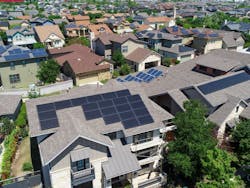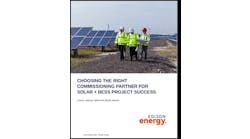Call them nanogrids, smart homes, or something else, households are increasingly shaping up as a means to leverage grid flexibility, and energy companies are stepping forward with a range of products to advance the market.
Circuit breakers, energy control platforms, batteries, aggregations, virtual power plants, non-wires alternatives and building electrification are being configured to make homes into grid assets.
Some of the latest unveilings in the US come from Eaton, Sunverge, Sunrun and Southern California Edison. And in England, UK Power Networks (UKPN) recently announced a $17 million investment into a range of grid flexibility contracts, with some using household assets.
Aggregated together, households are seen as a significant way to manage ever-shifting grid supply and demand, particularly as consumers begin to charge electric vehicles at home.
Eaton & Sunverge bypass need for smart appliances
If you’re thinking all of this requires that consumers purchase smart home appliances, Eaton and Sunverge are saying think again. They’ve announced a product that they say gives utilities the ability to manage 80 percent of household load without relying on smart appliances.
The system brings together Eaton’s circuit breaker energy management technology with Sunverge’s energy management platform. Utilities gain the ability to manage a variety of resources in the home, including distributed energy resources, according to a Sunverge release.
The collaboration allows utilities to orchestrate home energy systems in near real-time, and undertake aggregation and dynamic load management at the distribution circuit level, according to Martin Milani, CEO of Sunverge. Utilities can manage both base load and peak load, as well as frequency response and regulation, black start loading, and other grid services.
Critical to electrification
Using homes in this way makes electricity more valuable to homeowners, since they are likely to gain revenue, energy savings or backup power by offering their home’s energy assets for grid use. As a result, consumers become more inclined to use electricity over other fuels in their homes, boosting society’s move toward increased electrification, what Milani described as “a fast-growing trend integral to decarbonizing our energy consumption.”
Added Andrew Bouthilet, vice president, segment solutions at Eaton: “This granular level of insight and control paired with Sunverge’s tried-and-true real-time DER control and aggregation platform will enable flexible load management, which is critical to enabling fully electrified homes and buildings.”
The product fits squarely into the mission of each partner. Eaton is a power management firm with a footing in the microgrid space. Sunverge is known for its cloud-based energy management systems that enable virtual power plants.
The Eaton Experience Center near Pittsburgh. Photo provided by Eaton
Other companies also are focusing on the circuit breaker as the link to the grid. Span, a San Francisco-based company led by executives and lead engineers from Tesla, Amazon Echo, and Sunrun, in May raised $10.2 million and has begun commercializing the smart circuit panel.
The panel creates a single point of control for generation, energy storage and devices in the home. When the power goes out, Span automatically islands the house and allows the homeowner, via a cell phone, to prioritize energy use for appliances and connected devices, so that the most important are energized first.
Sunrun and SCE create residential virtual power plant
Meanwhile, Sunrun this week said that it is working with mega utility Southern California Edison (SCE) to launch a virtual power plant comprised of residential energy storage systems.
At the center of the project is Sunrun’s Brightbox, a solar and storage system for the home. The partners plan to install 300 Brightbox systems in homes from now through mid-2021.
The utility plans to leverage the homes when the grid is under strain, such as on hot summer days. However, if there is a grid power outage, the household takes precedence, using the system as backup power. Sunrun will generate revenue by managing and dispatching the virtual power plant to the grid when the utility needs the resource. Homeowners will receive incentives for participating.
UK utility moves big on grid flexibility
Across the pond, the use of distributed energy resources for grid flexibility took a big jump this week with the announcement by UK Power Networks (UKPN), that it has made its largest award for flexibility resources yet.
The utility, which serves South East England, the East of England and London, will allot $17 million to 16 providers for 123 MW of flexible power to serve two million homes and businesses, about 10% of its customers.
Chosen via a solicitation, the grid resources include household electric vehicles, batteries, and solar plus storage, according to a UKPN spokesperson.
The utility sees the program as a way to grow the markets for low-carbon distributed energy resources. The flexibility resources also act as non-wires alternatives — they allow the utility to forego building new substations or laying cable, a less expensive approach that lowers customer costs, according to UKPN.
“Flexibility is the future because it is arguably the single most important element of a decarbonized smart electricity network” — Sotiris Georgiopoulos, UKPN
The program is particularly noteworthy, says the utility, because it undertakes the first low voltage flexibility agreements for an energy network in the world. The utility also is contracting for resources to serve high voltage zones.
UKPN was an early entrant into the grid flexibility market in 2018, when it published a flexibility roadmap. Now, the new contracts bring its total grid flexibility portfolio up to 142.3 MW
“Flexibility is the future because it is arguably the single most important element of a decarbonized smart electricity network. It gives us the flexibility we need to enable more renewable energy and forms a crucial element of the journey towards net zero,” said Sotiris Georgiopoulos, UKPN’s head of smart grid development.
Track news about use of microgrids and nanogrids for grid flexibility. Subscribe to the free Microgrid Knowledge newsletter.







